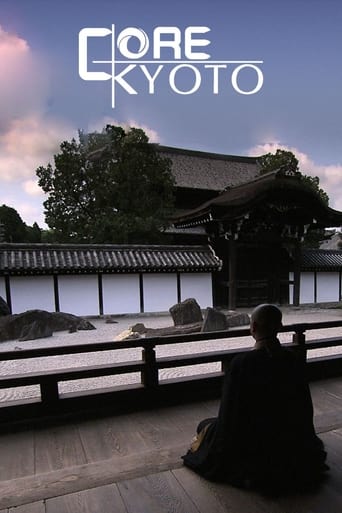Core Kyoto Season 9
The timeless heart of Japan's ancient capital. Against its rich backdrop of culture and tradition, today's Kyoto continues to innovate and inspire.
With 30 Day Free Trial!
Core Kyoto
2013 / NRThe timeless heart of Japan's ancient capital. Against its rich backdrop of culture and tradition, today's Kyoto continues to innovate and inspire.
Watch Trailer
Core Kyoto Season 9 Full Episode Guide
Kyoto abounds with customs and traditions involving dramatic masks, such as Noh, a UNESCO Intangible Cultural Heritage; Nenbutsu Kyogen, comedic theater performed by amateur actors; and handcrafted Saga masks made in Saga-Arashiyama and used as protective charms. In contemporary times, masks are seen as symbols that hold communities together, offering solace to people during the coronavirus pandemic. Discover the world of theatrical masks through their history and evolution over the centuries.
Beans are a beloved food eaten every day in Kyoto, but they are also a sacred legume used in imperial rites. Soybeans arrived in Japan along with Buddhism in the 6th century and were a mainstay in the vegetarian cuisine of monks. Adzuki beans, brought back from China by the famed monk Kukai in the 9th century, are used in auspicious foods to ward off misfortune. Discover how beans are more than mere cooking ingredients in the ancient capital, where they play a vital role in rituals and customs.
Tokonoma are a unique feature of tatami rooms, originally found in affluent households. Through the centuries, they slowly became standard fixtures for all social classes, including commoners. These alcoves were places of prayer for Buddhist monks, symbols of power for samurai, and condensed expressions of hospitality and beauty in the world of tea. Discover how tokonoma function in worship, and as places of welcome and spaces to admire artistic objects.
Expressing the infinite expanse through kanji characters brushed in shades of ink. Lying among the characters on the canvas, creating humanized works. Designing calligraphy to exude personality and authority. Embedding characters with a message for the coronavirus-plagued era. Discover the calligraphic world of Kyoto through the calligraphers who find freedom in wielding their brushes, while keeping a solid footing in tradition.
Since ancient times taiko have been instruments of communication with the deities. They provided inspiration as lively accompaniment to performing arts and continue to play a vital role in strengthening community ties. Wachidaiko are rooted in a legend of dispelling demons. In August drums welcome ancestral spirits on their annual visit. One family upholds 200-year-old drum-making techniques. A school instills seniors with purpose and energy. Discover the taiko culture of the ancient capital.
Sake brewing prospered for centuries on Kyoto's abundant water supply and quality rice. But demand has dropped recently with the increase of a variety of alcoholic beverages. Brewers search for new drinks that suit modern needs while preserving traditions. One brewery makes beer with water originally slated for sake. A biotechnology institute collaborates with sake breweries to produce sake for overseas consumption. Discover how breweries are promoting new ways to enjoy sake during the pandemic.
Wire netting techniques originated over 1,000 years ago in netting to repel birds and religious altar fittings and treasures, such as sutra receptacles. The intricate geometrical patterns can only be created by hand. Today the craft is mostly used in cooking utensils. Kyoto once had 30 workshops, but a handful remain in operation. Discover the world of wire netting through the efforts of a father-son team looking to keep the traditional craft alive through revolutionary advances in technology.
Verdant, furry moss, of which there are some 1800 varieties, has the power to fascinate. Moss makes a literary appearance in an early-10th-century poem. Later a culture revolving around moss appreciation evolved through the influence of Zen and the Way of Tea's aesthetic concept of "refined and rustic." During the pandemic, moss is enjoying a comeback, and people are finding solace in moss terrariums and other interior items. Discover the complex yet delicate beauty of this lush greenery.
The eastern mountains once hosted many climbing kilns, attracting scores of potters. Kyo-yaki pottery evolved in its diversity for use in cooking and tea ceremonies. Modern potters uphold the old ideals while creating fresh works. One potter uses scissors to adorn her work with floral designs. One produces ceramics for use in construction. Another creates nouveau pieces based on research into a classical style. Discover how potters propel their craft into the future, unbound by tradition.
Karakami is washi woodblock-printed with nature motifs and geometric patterns. Arriving from China around 1,000 years ago, this ornamental paper came to be used in interiors as wallpaper and on sliding doors. One artisan sublimely imbues his artworks with prayer. Another strives to perfect the world of minimal, beautiful handiwork. Discover how artisans are propelling Karakami into the future through accessories, fixtures and hotel interiors, transcending the world of Japanese aesthetics.
In Kyoto, traditional cooking stoves affectionately called Okudo-san were once the heart of the household and the focus of belief in the deity of fire. With the proliferation of electric rice cookers, the stoves began to disappear from use. Recently more people are forgoing convenience and learning the benefits of cooking on an open flame. Some still use their ancestors' stoves in their businesses. Discover how people are reevaluating their lifestyles during the pandemic through their Okudo-san.
Shigemori Chisao, grandson of landscape gardener Mirei, creates modern gardens in Japan and abroad, taking inspiration from dry-landscape Karesansui. This type of garden evolved in Zen temples in the 1400s and uses rocks to represent land and water. In his original glassworks artist Nishinaka Yukito recreates the "imperfect beauty" tea master Oda Urakusai advocated 400 years ago. Explore what it means to recompose beauty through 2 artists heavily influenced by the giants of the Kyoto artworld.
The Tango district in northern Kyoto Pref. is Japan's largest producer of a supple fabric, supplying 60% of the kimono industry. The elegantly crimped texture makes it easy to dye. But with the proliferation of Western clothing, production has dropped to as far as 3% of the industry's heyday. The pandemic was an additional blow. Young artisans are exploring new materials to capture the world. Discover how this 300-year-old textile evolved and its ties with the ancient capital.
The traditional, wooden townhouses built prior to 1950 that dot the downtown area of Kyoto served as both living and work spaces. American Jeff Berglund, university professor and Kyoto tourism ambassador, lives in one built 160 years ago. A Japan resident for 50 years, Berglund aspires to living in harmony with nature. He honors the customs of old that are still practiced today and promotes Japan's culture abroad. Discover the pleasures of living in a Machiya through Berglund's daily encounters.
Reizei Kimiko is the daughter of the 24th head of a once aristocratic family. Together with her husband, she upholds traditions in Waka poetry and other court rituals. Sugimoto Setsuko, the 10th generation of a former merchant family, preserves their Machiya townhouse for posterity and promotes the Obanzai style of cooking. Maintaining their family foundations, they both have faced adversity with the current pandemic. Discover the joy, pride and responsibility of carrying on family traditions.
Mountainous Keihoku in Kyoto's north is more than 90% woodlands. The drastic temperature differences and the frequent rain and mist are ideal conditions for forestry. For more than 1,200 years the area supported the ancient capital's prosperity, supplying it with raw materials and food supplies. Residents carry on the trades of their ancestors, coexisting with nature. Discover how Keihoku is attracting attention from people wanting to learn the customs of old to build a sustainable future.
Hosoo Masataka, the 12th-generation of a Nishijin brocade producer, is making waves abroad as he updates the Nishijin brand with new technology and textiles. Tokyo-based architect Aoki Jun is director of the Kyoto City KYOCERA Museum of Art that reopened in 2020. His renovations introduced an open-plan that blends in with the surroundings and encourages interaction among visitors. Both share a deep appreciation of Kyoto aesthetics: one from within the city and the other from outside.
Free Trial Channels
Seasons















































